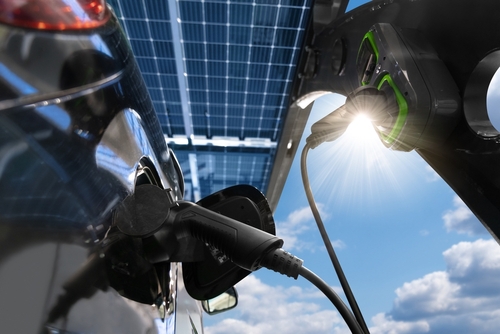The journey toward Commercial Energy Efficiency and more sustainable practices isn’t just a trend; it’s a strategic approach toward a greener future. In the pursuit of Environmental, Social, and Governance (ESG) goals, commercial and industrial companies are increasingly steering their focus toward sustainability initiatives. However, the order in which these projects are undertaken can significantly impact their effectiveness and overall outcomes.

Some companies dive straight into prominent sustainability projects like installing solar panels. While these initiatives have a role in the process, embracing energy efficiency projects, particularly LED lighting upgrades, as a foundational step toward achieving ESG goals holds immense strategic value. Here’s why:
Strategic Benefits of Prioritizing LED Lighting Projects Before Sustainability Projects
1. Minimizing Electrical Load to Maximize Solar Potential
Before considering solar installations, it’s critical to reduce the existing electrical load. Upgrading lighting systems to energy efficient LED technology slashes energy consumption significantly. This reduction not only minimizes energy wastage but also optimizes the potential output of subsequent solar projects. By beginning with an investment grade lighting audit and lowering the overall demand, EPCs can help optimally engineer the kW requirement of the solar PV system; hence reducing the project cost.
2. Speedy Returns with Faster Payback Periods
One of the remarkable benefits of lighting retrofit upgrades is their rapid payback periods. Unlike solar projects, which often involve substantial upfront costs and the potential need for financing support through Energy as a Service or PPAs, LED lighting upgrades demonstrate quicker returns on investment. This faster payback allows firms to swiftly reinvest the savings generated from these projects into other sustainability initiatives.
3. Using Energy Savings as a Catalyst for Further Sustainability
The annual energy savings achieved through LED lighting initiatives act as a financial catalyst for broader sustainability initiatives. Proficiently managing Energy Efficiency projects establishes a strong foundation, gaining leadership support for subsequent Sustainable Energy projects. An EE initiative functions as a valuable “proof of concept” for future reporting, funding, and the comprehensive design of SE programs. These savings directly offset expenses in larger-scale sustainability projects, like solar installations, ensuring a strategic and sustainable allocation of resources. Explore further insights on prioritizing energy projects in our blog post, A Guide To Prioritizing Energy Conservation Projects.
4. Leveraging Advanced Controls for Enhanced Efficiency
Integrating smart or networked lighting controls amplifies the efficiency gains achieved through LED upgrades. Features like daylight harvesting and peak load shedding further curtail electrical demand, maximizing energy savings. The DesignLights Consortium’s 2023 study emphasizes the immense energy-saving potential of networked lighting controls, especially when integrating HVAC controls via lighting system-based occupancy sensors. Demonstrating a 50+% reduction in LED energy consumption, these controls offer up to 5-10% total commercial building energy reduction. Arizona and Connecticut stand to gain $217 million and $1.2 billion respectively by 2030 through adopting these systems. Such integrated systems not only enhance efficiency but also demonstrate a commitment to harnessing cutting-edge technology for sustainability efforts and substantial energy savings.
5. Maximizing Utility and Tax Incentives
Embarking on energy efficiency projects allows a company to leverage a myriad of utility and tax incentives. These incentives serve as invaluable support in funding subsequent sustainability initiatives like solar projects, battery storage, and EV Charging Stations to amplify their financial viability and overall impact.

In essence, starting the ESG journey can have its challenges, but beginning with energy efficiency projects is key to laying a strong foundation for a sustainable future. These projects serve as precursors, not inhibitors, to larger sustainability endeavors. By strategically managing electrical load, maximizing efficiency gains, and leveraging financial incentives, companies can pave a smoother, more financially viable path toward achieving holistic ESG goals.
At Eco Engineering, we understand the pivotal role of commercial energy efficiency in driving sustainable transformations for commercial and industrial entities. Our 30 years of expertise lies in guiding organizations through the strategic implementation of LED lighting upgrades and facilitating the seamless integration of sustainable solutions like solar projects. Together, let’s illuminate the path to a greener and more sustainable future.
Learn more about our services and how we can provide guidance to achieve commercial energy efficiency with our proven and consistent processes for centralized project management or contact us now.
In the pursuit of environmental sustainability and commercial energy efficiency within any organization, it is essential to establish commitments, set goals, develop a strategic approach, and create a practical operational roadmap. As a result, companies have focused on adding specialized sustainability roles, teams, and task forces. However, some may face a significant challenge – a lack of awareness and expertise in strategically prioritizing Energy Conservation Measure (ECM) projects for effective energy-saving initiatives. This knowledge gap can be reduced when companies consider guidance and expertise from an Engineering, Procurement, and Construction (EPC) firm in the energy sector. This approach not only streamlines the process but also makes the sustainability program more appealing and accessible to internal teams.

EPC contractors can play a crucial role in helping companies prioritize energy conservation projects to achieve their climate goals as part of their overall Environmental, Social, and Governance (ESG) and sustainability objectives. Here’s a step-by-step guide outlining on how EPC firms can assist to prioritize energy conservation projects:
Step-by-Step Process Guide to Prioritizing Energy Conservation Projects
1. Baseline Assessment: Eco Engineering suggests starting the journey toward greater energy efficiency with a thorough baseline assessment. This assessment involves conducting a comprehensive energy audit, including an investment-grade lighting audit assessment of your facilities and operations. This audit can cover various aspects, such as analyzing your current energy consumption, assessing utility costs, and evaluating the potential for utility rebates. The initial focus of this assessment is on upgrading to LED lighting, marking the initial step towards achieving commercial energy efficiency.
2. Commercial Energy Efficiency Goals: Our approach can include close collaboration with sustainability leaders and stakeholders within your organization. We work together to gain insights into your current energy goals, assess any progress already made, and identify potential opportunities for improvement. Our goal is to help you establish clear and measurable energy objectives, along with the key performance indicators (KPIs) that align with these objectives.
If you’ve encountered challenges in gaining internal buy-in from various teams with differing priorities, we can assist in supporting a strategic business plan to effectively convey your message (read more about the Top 10 Challenges in our blog). By identifying both the goals you want to achieve and the obstacles in your path, we often find it beneficial to plan in reverse, crafting a robust business plan that appeals to cross-functional teams with diverse objectives. This approach ensures that your energy efficiency initiatives are appealing and align with the interests of different internal stakeholders.

3. Identify Energy Conservation Opportunities: Our approach can help you evaluate the potential of an overall building retrofit and prioritizing energy conservation measures that can contribute to achieving energy goals. These may include:
• Lighting Retrofits: Assess the feasibility and benefits of upgrading to energy-efficient LED lighting systems and controls.
• Building Envelope Optimization: Examine opportunities to enhance insulation, windows, and roofing for better energy efficiency.
• Renewable Energy: Consider the integration of solar pv as renewable energy sources.
• HVAC Upgrades: Evaluate improvements in heating, ventilation, and air conditioning systems.
• Energy Management Systems (EMS): Explore the implementation of EMS for better control and monitoring of energy usage.
• Electric Vehicle (EV) Charging Infrastructure: Assess the potential for EV charging stations to meet the needs of your customers and employees.
4. Prioritization Criteria: To develop a set of criteria for prioritizing projects, consider factors such as:
• Cost-Benefit Analysis
• Expected energy savings, operational savings, and emissions reductions.
• Alignment with ESG and sustainability goals.
• Regulatory compliance and reporting requirements.
• Ease of implementation and disruption to operations.
• Risk Assessment – Check out this infographic from Climate Group RE100 to mitigate common myths about renewable electricity.
5. Project Sequencing: Develop a roadmap for project implementation, taking into account the prioritization criteria, available budget, and timelines. Financing is one of the top challenges in the energy transition but there are options such as Energy-as-a-Service (Eaas) that can be considered. Determine which projects should be initiated first and create a phased plan for execution. This can be the most difficult part if sustainability leaders have limited knowledge and need the expertise of an EPC as a guide to strategically prioritizing Energy Conservation projects.
6. Monitoring and Reporting: Implement robust monitoring and reporting mechanisms with controls and metering to track the progress of each project. Measuring energy savings, carbon emissions reductions, and other relevant KPIs can demonstrate the ongoing impact on ESG goals.
By following these recommended steps, an EPC contractor can assist companies in identifying, prioritizing, and implementing energy conservation projects that align with their ESG and sustainability objectives. This collaborative effort helps organizations make informed decisions, maximize the impact of their investments, and demonstrate their commitment to sustainable practices and responsible governance.
For the past 30 years, Eco Engineering has been dedicated to prioritizing our customers’ specific goals and providing customized energy service solutions aimed at maximizing both energy and cost savings.
Learn more about our services and how we can provide guidance to achieve commercial energy efficiency with our proven and consistent processes for centralized project management or contact us now.

